light Lexus GS350 2007 Using the front audio system / LEXUS 2007 GS430/350 OWNER'S MANUAL (OM30A04U)
[x] Cancel search | Manufacturer: LEXUS, Model Year: 2007, Model line: GS350, Model: Lexus GS350 2007Pages: 562, PDF Size: 17.95 MB
Page 479 of 562
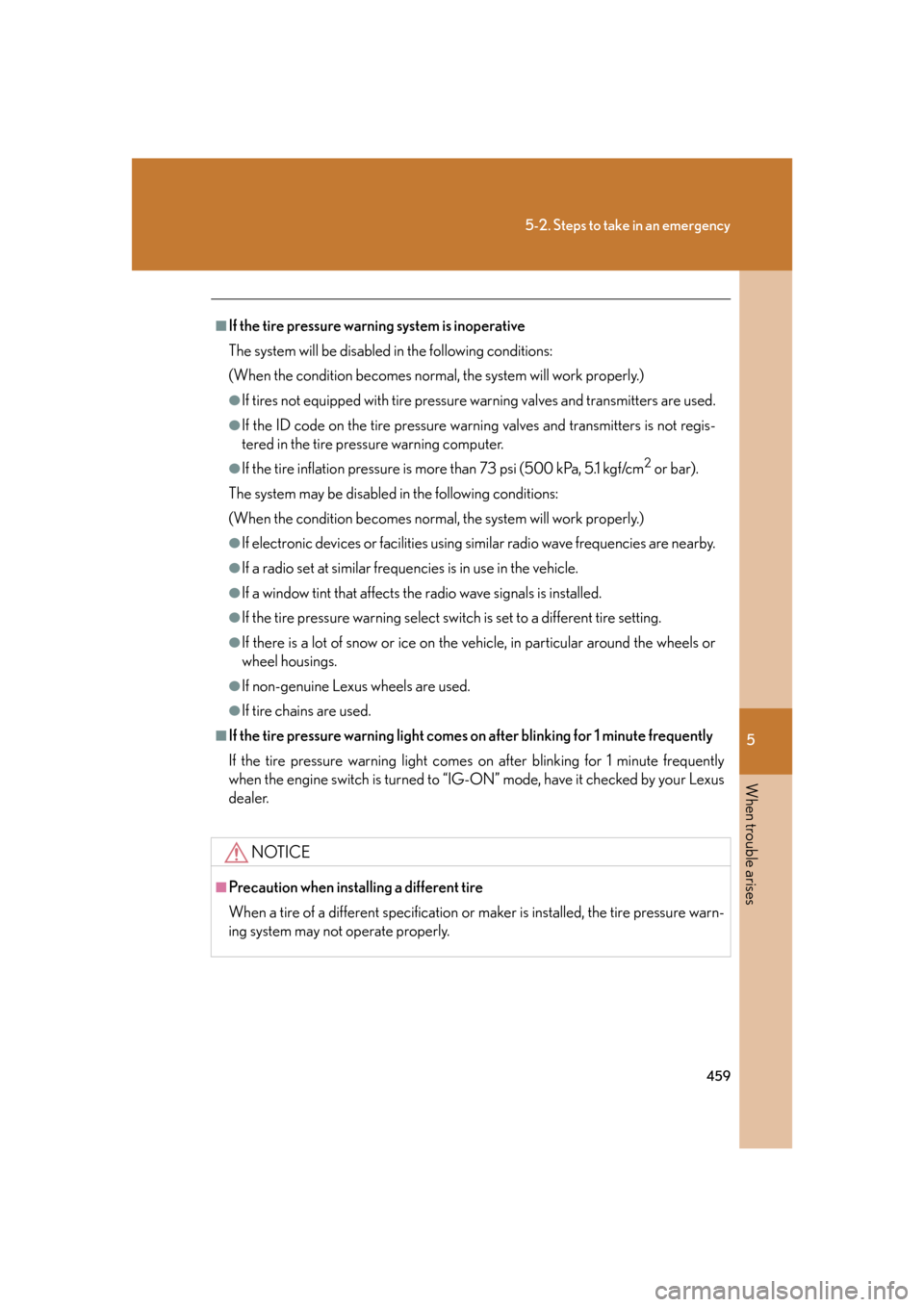
5
When trouble arises
459
5-2. Steps to take in an emergency
■If the tire pressure warning system is inoperative
The system will be disabled in th
e following conditions:
(When the condition becomes normal, the system will work properly.)
●If tires not equipped with tire pressure warning valves and transmitters are used.
●If the ID code on the tire pressure warning valves and transmitters is not regis -
tered in the tire pressure warning computer.
●If the tire inflation pressure is more than 73 psi (500 kPa, 5.1 kgf/cm2 or bar).
The system may be disabled in the
following conditions:
(When the condition becomes normal, the system will work properly.)
●If electronic devices or facilities using similar radio wave frequencies are nearby.
●If a radio set at similar frequencies is in use in the vehicle.
●If a window tint that affects the radio wave signals is installed.
●If the tire pressure warning select switch is set to a different tire setting.
●If there is a lot of snow or ice on the vehicle, in particular around the wheels or
wheel housings.
●If non-genuine Lexus wheels are used.
●If tire chains are used.
■If the tire pressure warning light comes on after blinking for 1 minute frequently
If the tire pressure warning light comes on af
ter blinking for 1 minute frequently
when the engine switch is turned to “IG-ON” mode, have it checked by your Lexus
dealer.
NOTICE
■Precaution when insta lling a different tire
When a tire of a different specification or maker is installed, the tire pressure warn-
ing system may not operate properly.
Page 487 of 562
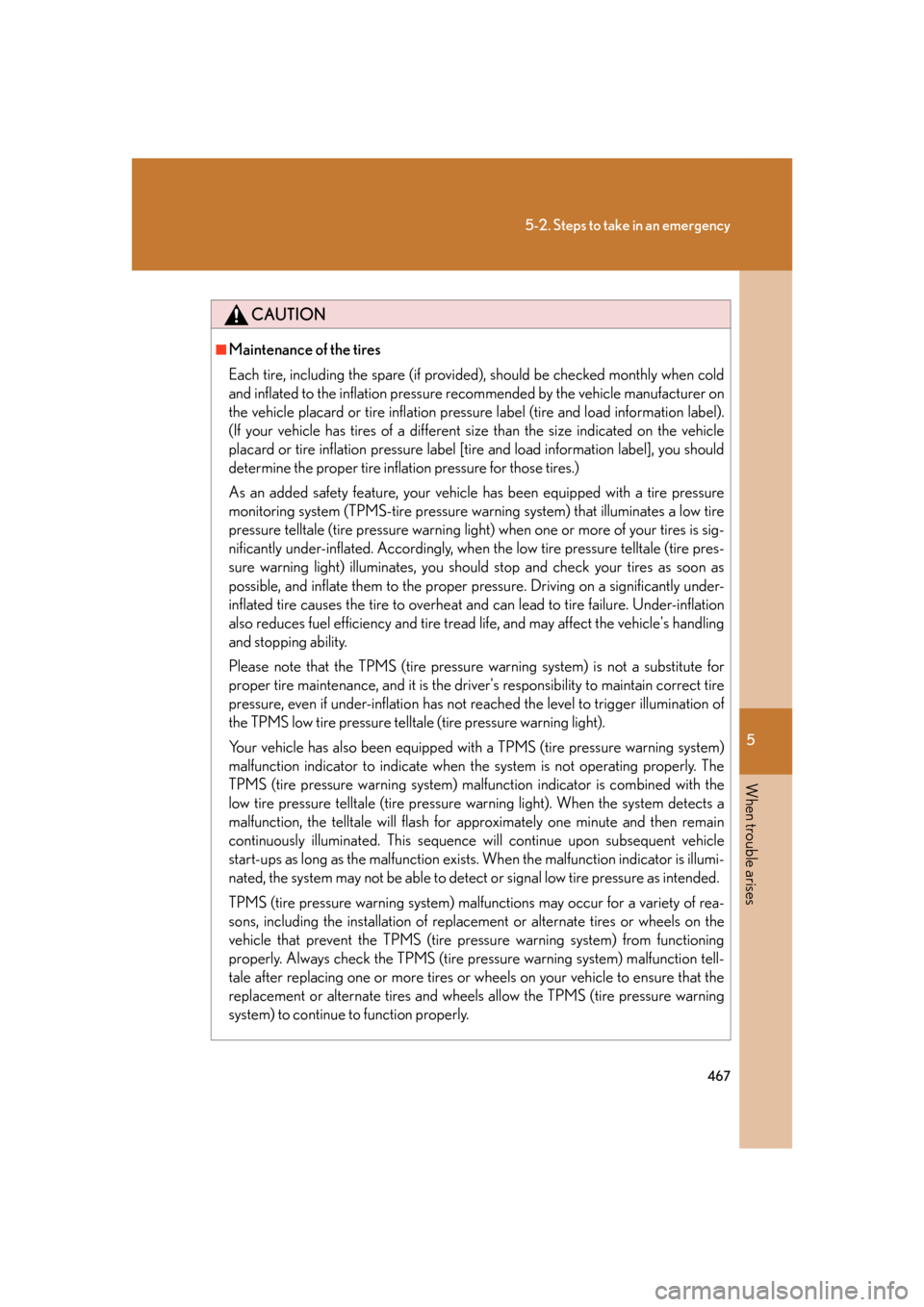
5
When trouble arises
467
5-2. Steps to take in an emergency
CAUTION
■Maintenance of the tires
Each tire, including the spare (if provided), should be checked monthly when cold
and inflated to the inflation pressure re commended by the vehicle manufacturer on
the vehicle placard or tire inflation pressure label (tire and load information label).
(If your vehicle has tires of a different size than the size indicated on the vehicle
placard or tire inflation pressure label [tire and load information label], you should
determine the proper tire inflation pressure for those tires.)
As an added safety feature, your vehicle has been equipped with a tire pressure
monitoring system (TPMS-tire pressure warning system) that illuminates a low tire
pressure telltale (tire pressure warning light) when one or more of your tires is sig-
nificantly under-inflated. Accordingly, when the low tire pressure telltale (tire pres-
sure warning light) illuminates, you should stop and check your tires as soon as
possible, and inflate them to the proper pressure. Driving on a significantly under-
inflated tire causes the tire to overheat an d can lead to tire failure. Under-inflation
also reduces fuel efficiency and tire tread life, and may affect the vehicle's handling
and stopping ability.
Please note that the TPMS (tire pressure warning system) is not a substitute for
proper tire maintenance, and it is the driver's responsibility to maintain correct tire
pressure, even if under-inflation has not reached the level to trigger illumination of
the TPMS low tire pressure telltale (tire pressure warning light).
Your vehicle has also been equipped with a TPMS (tire pressure warning system)
malfunction indicator to indicate when th e system is not operating properly. The
TPMS (tire pressure warning system) malf unction indicator is combined with the
low tire pressure telltale (tire pressure warning light). When the system detects a
malfunction, the telltale will flash for approximately one minute and then remain
continuously illuminated. This sequence will continue upon subsequent vehicle
start-ups as long as the malfunction exists . When the malfunction indicator is illumi-
nated, the system may not be able to detect or signal low tire pressure as intended.
TPMS (tire pressure warning system) malfunctions may occur for a variety of rea-
sons, including the installation of replacem ent or alternate tires or wheels on the
vehicle that prevent the TPMS (tire pressure warning system) from functioning
properly. Always check the TPMS (tire pressure warning system) malfunction tell-
tale after replacing one or more tires or wheels on your vehicle to ensure that the
replacement or alternate tires and wheels allow the TPMS (tire pressure warning
system) to continue to function properly.
Page 489 of 562
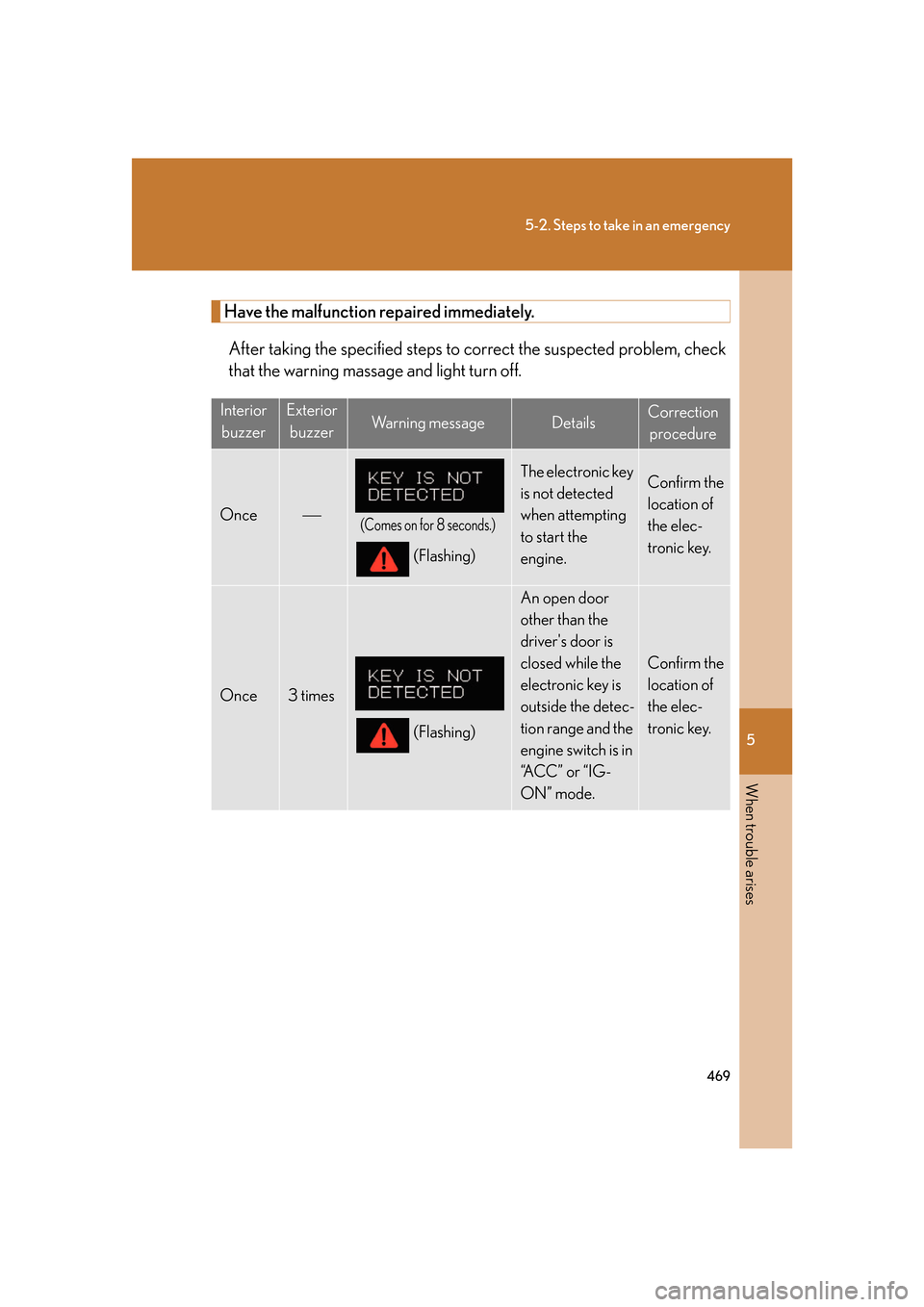
5
When trouble arises
469
5-2. Steps to take in an emergency
Have the malfunction repaired immediately.
After taking the specified steps to correct the suspected problem, check
that the warning massage and light turn off.
InteriorbuzzerExterior buzzerWa r n i n g m e s s a g eDetailsCorrection procedure
Once(Comes on for 8 seconds.)
(Flashing)
The electronic key
is not detected
when attempting
to start the
engine.Confirm the
location of
the elec-
tronic key.
Once3 times
(Flashing)
An open door
other than the
driver's door is
closed while the
electronic key is
outside the detec-
tion range and the
engine switch is in
“ACC” or “IG-
ON” mode.
Confirm the
location of
the elec-
tronic key.
Page 492 of 562

472
5-2. Steps to take in an emergency
If you have a flat tire (Vehicles with run-flat tires)
■In some condition (such as at high temperatures)
You can not continue driving for up to
100 miles (160 km).
■If you cannot distinguish between the standard tires and run-flat tires
Consult your Lexus dealer.
■For the detailed information on run-flat tires
See the tire warranty book.
NOTICE
■When replacing the tires
●Have the tires replaced by the nearest Lexus dealer or authorized tire dealer. The
tire pressure warning valves and transmitters will be affected by the installation or
removal of tires.
●Replace the grommets for the tire pressure warning valves and transmitters as
well.
■To avoid damaging the tire pressu re warning valves and transmitters
Do not use liquid sealants on flat tires.
Take your vehicle to the nearest Lexus dealer or authorized tire dealer as
soon as possible.
■ Run-flat tires (A “RFT” or “DSST” mark is molded on the sidewall)
You can continue driving a vehi-
cle with run-flat tires even if any
tir
e goes flat.
It is able to run for a maximum of
100 miles (160 km) at a speed
below 55 mph (90 km/h) after
the tire pressure warning light
comes on. ( P. 4 5 2 )
Page 494 of 562
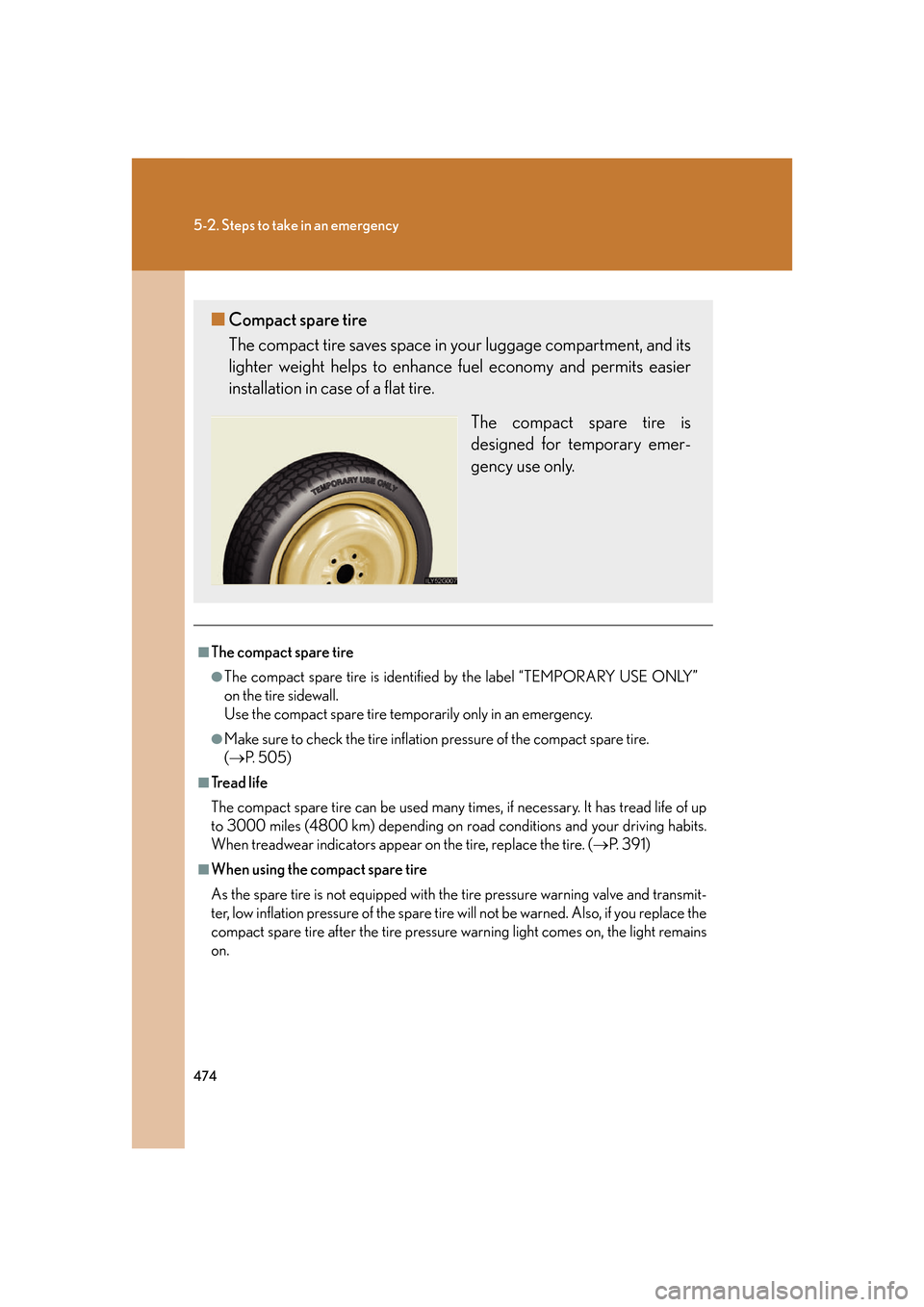
474
5-2. Steps to take in an emergency
■The compact spare tire
●The compact spare tire is identified by the label “TEMPORARY USE ONLY”
on the tire sidewall.
Use the compact spare tire temporarily only in an emergency.
●Make sure to check the tire inflatio n pressure of the compact spare tire.
( P. 505)
■Tr e a d l i f e
The compact spare tire can be used many times, if necessary. It has tread life of up
to 3000 miles (4
800 km) depending on road conditions and your driving habits.
When treadwear indicato rs appear on the tire, replace the tire. ( P. 3 9 1 )
■When using the compact spare tire
As the spare tire is not equipped with th e
tire pressure warning valve and transmit-
ter, low inflation pressure of the spare tire will not be warned. Also, if you replace the
comp
act spare tire after the tire pressure warning light comes on, the light remains
on.
■ Compact spare tire
The compact tire saves space in your luggage compartment, and its
lighter weight helps to enhance fuel economy and permits easier
installation in case of a flat tire.
The compact spare tire is
designed for tempor
ary emer-
gency use only.
Page 496 of 562

476
5-2. Steps to take in an emergency
Replacing a flat tire
Chock the tires.
Slightly loosen the wheel nuts (one
turn).
STEP1
Flat tireWheel chock positions
FrontLeft-hand sideBehind the rear right-hand side tire
Right-hand sideBehind the rear left-hand side tire
Rear
Left-hand sideIn front of the front right-hand side tire
Right-hand sideIn front of the front left-hand side tire
STEP2
Page 497 of 562

5
When trouble arises
477
5-2. Steps to take in an emergency
Turn the tire jack portion “A” by
hand until the notch of the jack is in
contact with the jack point.
Raise the vehicle until the tire is
slightly r
aised off the ground.
Remove all the wh eel nuts and the
tir
e.
When resting the tire on the
ground, place the tire so that the
wheel design faces up to avoid
scratching the wheel surface.
STEP3
STEP4
STEP5
Page 503 of 562

5
When trouble arises
483
5-2. Steps to take in an emergency
If the engine will not start
If the engine will not start even though correct starting procedures are
being followed (
P. 9 7), consider each of the following points.
■The engine will not start even wh en the starter motor operates
normally.
One of the following may be the cause of the problem.
● Ther
e may not be sufficient fuel in the vehicle’s tank.
Add fuel to the vehicle.
● The engine may be flooded.
Try to restart the engine once mor
e following correct starting
procedures.( P. 9 7 )
● Ther
e may be a malfunction in the engine immobilizer system.
( P. 5 2 )
■ The star
ter motor turns over slow ly, the interior lights and head-
lights are dim, or the horn does not sound or sounds at a lo
w vol-
ume
One of the following may be the cause of the problem.
● The batter
y may be discharged. (P. 4 9 2 )
● The batter
y terminal connections may be loose or corroded.
■ The star
ter motor does not turn over, the interior lights and head-
lights do not turn on, or the horn does not sound
One of the following may be the cause of the problem.
● One or both of the batter
y terminals may be disconnected.
● The batter
y may be discharged. (P. 4 9 2 )
Page 509 of 562
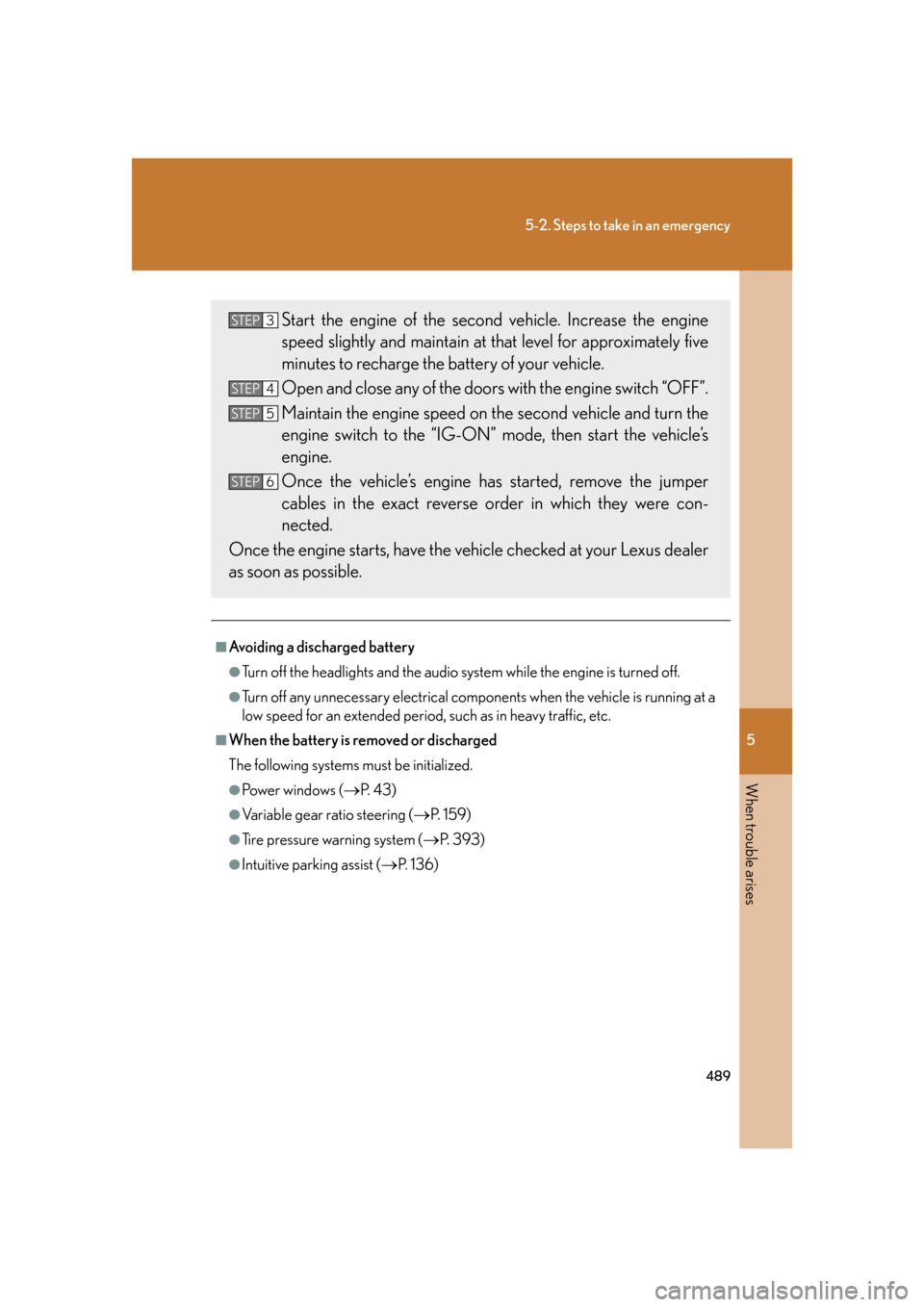
5
When trouble arises
489
5-2. Steps to take in an emergency
■Avoiding a discharged battery
●Turn off the headlights and the audio system while the engine is turned off.
●Turn off any unnecessary electrical compon ents when the vehicle is running at a
low speed for an extended period, such as in heavy traffic, etc.
■When the battery is removed or discharged
The following systems must be initialized.
●Po w e r w i n d o w s (P. 4 3 )
●Variable gear ratio steering (P. 1 5 9 )
●Tire pressure warning system (P. 3 9 3 )
●Intuitive parking assist (P. 1 3 6)
Start the engine of the second vehicle. Increase the engine
speed slightly and maintain at that level for approximately five
minutes to recharge the battery of your vehicle.
Open and close any of the doors with the engine s
witch “OFF”.
Maintain the engine speed on th e second v
ehicle and turn the
engine switch to the “IG-ON” mode, then start the vehicle’s
engine.
Once the vehicle’s engine ha s star
ted, remove the jumper
cables in the exact reverse ord er in which they w
ere con-
nected.
Once the engine starts, have the ve hicle check
ed at your Lexus dealer
as soon as possible.
STEP3
STEP4
STEP5
STEP6
Page 510 of 562

490
5-2. Steps to take in an emergency
CAUTION
■Avoiding battery fires or explosions
Observe the following precautions to prevent accidentally igniting the flammable
gas that may be emitted from the battery.
●Make sure the jumper cable is connected to the correct terminal and that it is not
unintentionally in contact with any pa rt other than the intended terminal.
●Do not allow the jumper cables to come into contact with the “+” and “-” termi-
nals.
●Do not allow open flame or use matches, cigarette lighters or smoke near the
battery.
■Battery precautions
The battery contains poisonous and corrosive acidic electrolyte, while related parts
contain lead and lead compounds. Observe the following precautions when han-
dling the battery:
●When working with the battery, always we ar safety glasses and take care not to
allow any battery fluids (acid) to come into contact with skin, clothing or the vehi-
cle body.
●Do not lean over the battery.
●In the event that battery fluid comes into contact with the skin or eyes, immedi-
ately wash the affected area with water and seek medical attention.
Place a wet sponge or cloth over the affected area until medical attention can be
received.
●Always wash your hands after handling the battery support, terminals, and other
battery-related parts.
●Do not allow children near the battery.